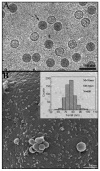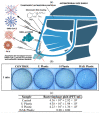Antiviral Characterization of Advanced Materials: Use of Bacteriophage Phi 6 as Surrogate of Enveloped Viruses Such as SARS-CoV-2
- PMID: 35628148
- PMCID: PMC9141689
- DOI: 10.3390/ijms23105335
Antiviral Characterization of Advanced Materials: Use of Bacteriophage Phi 6 as Surrogate of Enveloped Viruses Such as SARS-CoV-2
Abstract
The bacteriophage phi 6 is a virus that belongs to a different Baltimore group than SARS-CoV-2 (group III instead of IV). However, it has a round-like shape and a lipid envelope like SARS-CoV-2, which render it very useful to be used as a surrogate of this infectious pathogen for biosafety reasons. Thus, recent antiviral studies have demonstrated that antiviral materials such as calcium alginate hydrogels, polyester-based fabrics coated with benzalkonium chloride (BAK), polyethylene terephthalate (PET) coated with BAK and polyester-based fabrics coated with cranberry extracts or solidified hand soap produce similar log reductions in viral titers of both types of enveloped viruses after similar viral contact times. Therefore, researchers with no access to biosafety level 3 facilities can perform antiviral tests of a broad range of biomaterials, composites, nanomaterials, nanocomposites, coatings and compounds against the bacteriophage phi 6 as a biosafe viral model of SARS-CoV-2. In fact, this bacteriophage has been used as a surrogate of SARS-CoV-2 to test a broad range of antiviral materials and compounds of different chemical natures (polymers, metals, alloys, ceramics, composites, etc.) and forms (films, coatings, nanomaterials, extracts, porous supports produced by additive manufacturing, etc.) during the current pandemic. Furthermore, this biosafe viral model has also been used as a surrogate of SARS-CoV-2 and other highly pathogenic enveloped viruses such as Ebola and influenza in a wide range of biotechnological applications.
Keywords: SARS-CoV-2; antiviral characterization; antiviral materials; bacteriophage phi 6; biosafety conditions; coatings; composites; extracts; films; nanomaterials; porous supports.
Conflict of interest statement
The author declares no conflict of interest.
Figures







Similar articles
-
Non-Woven Infection Prevention Fabrics Coated with Biobased Cranberry Extracts Inactivate Enveloped Viruses Such as SARS-CoV-2 and Multidrug-Resistant Bacteria.Int J Mol Sci. 2021 Nov 24;22(23):12719. doi: 10.3390/ijms222312719. Int J Mol Sci. 2021. PMID: 34884521 Free PMC article.
-
Persistence of Bacteriophage Phi 6 on Porous and Nonporous Surfaces and the Potential for Its Use as an Ebola Virus or Coronavirus Surrogate.Appl Environ Microbiol. 2020 Aug 18;86(17):e01482-20. doi: 10.1128/AEM.01482-20. Print 2020 Aug 18. Appl Environ Microbiol. 2020. PMID: 32591388 Free PMC article.
-
Tiger Nut Milk's Antiviral Properties against Enveloped and Non-Enveloped Viruses: Effect of Concentration and Adding Sugar.Int J Mol Sci. 2023 Jul 27;24(15):12018. doi: 10.3390/ijms241512018. Int J Mol Sci. 2023. PMID: 37569397 Free PMC article.
-
Antiviral Properties of Alginate-Based Biomaterials: Promising Antiviral Agents against SARS-CoV-2.ACS Appl Bio Mater. 2021 Aug 16;4(8):5897-5907. doi: 10.1021/acsabm.1c00523. Epub 2021 Jul 13. ACS Appl Bio Mater. 2021. PMID: 35006918 Review.
-
Antimicrobial Nanomaterials and Coatings: Current Mechanisms and Future Perspectives to Control the Spread of Viruses Including SARS-CoV-2.ACS Nano. 2020 Oct 27;14(10):12341-12369. doi: 10.1021/acsnano.0c05937. Epub 2020 Oct 9. ACS Nano. 2020. PMID: 33034443 Review.
Cited by
-
Multifunctional materials with potential antiviral applications in face masks, face shields, and hydrogels against mpox virus.Sci Rep. 2025 Sep 1;15(1):32075. doi: 10.1038/s41598-025-17955-6. Sci Rep. 2025. PMID: 40890394 Free PMC article.
-
Advanced and Smart Textiles during and after the COVID-19 Pandemic: Issues, Challenges, and Innovations.Healthcare (Basel). 2023 Apr 13;11(8):1115. doi: 10.3390/healthcare11081115. Healthcare (Basel). 2023. PMID: 37107948 Free PMC article. Review.
-
Destruction of virus particles via mechanical and chemical virucidal activity of nanocolumnar copper thin films.Mater Today Bio. 2025 Apr 24;32:101803. doi: 10.1016/j.mtbio.2025.101803. eCollection 2025 Jun. Mater Today Bio. 2025. PMID: 40391021 Free PMC article.
-
Biological Properties of Recently Described Wild Bramble Rubus oklejewiczii against the Species from Similar Niches.Foods. 2024 Jan 21;13(2):337. doi: 10.3390/foods13020337. Foods. 2024. PMID: 38275704 Free PMC article.
-
Methods to assess environmental surface disinfectants against viruses: the quest and recommendations for a globally harmonized approach to microbicide testing.Infect Prev Pract. 2024 Aug 29;6(4):100395. doi: 10.1016/j.infpip.2024.100395. eCollection 2024 Dec. Infect Prev Pract. 2024. PMID: 39346619 Free PMC article. Review.
References
-
- Serrano-Aroca Á., Takayama K., Tuñón-Molina A., Seyran M., Hassan S.S., Pal Choudhury P., Uversky V.N., Lundstrom K., Adadi P., Palù G., et al. Carbon-Based Nanomaterials: Promising Antiviral Agents to Combat COVID-19 in the Microbial-Resistant Era. ACS Nano. 2021;15:8069–8086. doi: 10.1021/acsnano.1c00629. - DOI - PubMed
Publication types
MeSH terms
Substances
Grants and funding
LinkOut - more resources
Full Text Sources
Medical
Miscellaneous

